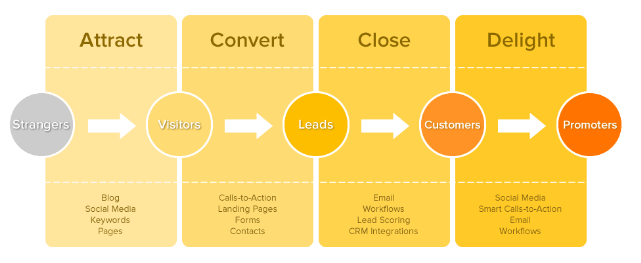 A topic has come up repeatedly in conversations that I’m having with executives. They’re sharing with me their concerns that inbound marketing may not be an appropriate or effective strategy for them because they compete in a clearly defined and a relatively limited (in size) market.
A topic has come up repeatedly in conversations that I’m having with executives. They’re sharing with me their concerns that inbound marketing may not be an appropriate or effective strategy for them because they compete in a clearly defined and a relatively limited (in size) market.
They’re concerned that inbound is an effective strategy for companies that have very large “tops” to their funnels, but in cases where there may be as few as 50 companies (or 200 or 2,000) that inbound isn’t a viable approach.
While the question is reasonable, the concern is not. It actually represents (what I believe at least) a common misunderstanding about inbound marketing. The confusion lies in the belief that the primary purpose of inbound is to “grow the top of the funnel.” While inbound is certainly a great strategy to do that, it’s impact is far, far greater.
I point out to these executives that inbound is about far more than just growing traffic or even leads. At its core, inbound is a philosophy more than anything else. The philosophy is based upon two concepts:
- The four part path to success is Attract - Convert - Close - Delight.
- The best way to do that is by creating valuable content (in the eyes of your customer) and to always be helping, rather than by interrupting and to always be closing.

These concepts are applicable regardless of the size of your market.
The Question Shouldn’t Be “Will Inbound Marketing Work For Me?” But, Rather “How Should I Design My Playbook So That It Does Work?”
While the size of your market isn’t a factor, it absolutely will impact how you design and implement your strategy. Here are five tips to make inbound marketing work in smaller, more defined markets.
1. Focus just below the top of the funnel
We work with several companies that have a highly defined market. With the right strategy, they don’t have a “top of the funnel problem.” A big advantage of such a market is that it’s relatively easy to identify and effectively target potential customers.
While identifying qualified targets is far easier, attracting them is not. You must focus on creating content that resonates with thembefore they’ve identified a need for your product or service. If all of your content is focused on the consideration/decision phase, you’ll find yourself in highly competitive situations, with greater risk of commoditization.
2. Be certain to identify the companies that fit that are in your market space
A couple of months ago, I was presenting to a group of executives. One of them called me out saying that he didn’t need to worry about all of these lead generation strategies I was talking about. He told me that there were only 100 - 200 companies that his company was focused on.
I responded by asking him two questions:
- Are those 100 - 200 companies identified and in your database?
- Have you identified the 4 - 6 key players in each of those companies and added those names to your database as well?
After some mumbling and “storytelling” he admitted that he had not done that. His mistake is common. If your market is small, then there is absolutely no reason that you shouldn’t fully understand the issues facing each company and know who every key person is. With that information you can implement a highly personalized, contextualized outreach process.
3. Spend extra time on defining your buyer personas
The smaller your defined market, the clearer and deeper you must be on understanding your buyer personas and ideal client profile. I often use the bowling alley as an analogy for growing your business. When bowling, your goal is to knock 10 pins down with one ball; but you don’t aim for 10 pins. Instead you aim to hit the headpin in the right spot, with the right spin and the right velocity; momentum takes care of the rest.
In highly defined markets, you don’t have 10 pins to knock down (each pin represents a market segment). Instead you may only have one pin. In this case, that pin is most likely big and solidly in place. Therefore you must “hit” it with greater velocity.
Doing this requires that you really understand who you’re looking to connect with at a much deeper level. You need to know what’s high on their agenda, the threats they’ve identified and the opportunities they’re trying to capture.
4. Clearly define your buyer’s journey
In tight markets, the four standard stages (Epiphany, Awareness, Consideration, Decision) of the buyer’s journey are not enough (frankly, it’s not enough in broad market either). You must get more granular. You can begin by answering these questions:
- What’s on the minds of your buyers that originates the journey that ultimately leads to the purchase of your product/service? Be sure to answer this question for each of your primary personas.
- What are the key initiatives that are already on our personas’ plates that we connect to?
- What triggers a change between seeking answers and insights to searching for solutions?
- How do they manage the purchase decision?
By building what we like to call the Alpha Journey, you can align the actions between all parties associated with generating demand.
5. Identify multiple entry points
Everyday I’m shocked by the number of salespeople that still only target one or two people at a company. Almost by definition, if a market is tightly defined with relatively few players, the average sale value is going to be fairly large. This means you’re going to impact multiple people, and multiple roles will influence the actions your target company takes.
One of the biggest challenges your prospects have is that different people and different roles speak different “languages,” making it hard to create the consensus needed today to drive decisions forward. Inbound strategies are great for building awareness and for creating a common “language” for assessing problems and opportunities.
While the “plays” for a company that competes in a tight market may be different than one that competes in a broader market, the underlying challenges both companies face are the same. The need to create value and lead prospects through their journey is crucial for success, and there are few if any approaches that do that better than inbound marketing.

 Doug Davidoff
Doug Davidoff